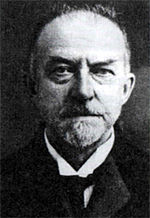Konstantīns Pēkšēns
| Konstantīns Pēkšēns | |
|---|---|
 |
|
| Born |
3 March 1859 Ņuki, Mazsalaca parish, Russian Empire (now Latvia) |
| Died | 23 June 1928 (aged 69) Weimar Republic, Bad Kissingen |
| Nationality | Latvian |
| Education | Riga Polytechnic Institute |
| Known for | Architecture |
| Movement | Art Nouveau |
| Patron(s) | Jānis Baumanis |
Konstantīns Pēkšēns (born 3 March 1859, Mazsalaca parish, Russian Empire — died 23 June 1928, Bad Kissingen, Weimar Republic) is one of the most prominent Latvian architects of all times. After Jānis Baumanis he is the epitome of the second generation of Latvian architects. Many Latvian cities and towns take pride in buildings designed by Pēkšēns, but Riga alone can boast more than 250 multi-storey brick buildings and a great number of wooden houses erected following his designs.
Pēkšēns was born in the Nuķi estate near Mazsalaca but in 1896 his family moved to Riga. 1875, Pēkšēns began studies at Riga Polytechnical Institute — at first in the Engineering Department, but from 1880 in the Department of Architecture. He took an active part in social life of students, was founding member of Selonija, a fraternity of Latvian students, participated much in sports. He graduated from the institute in 1885 and spent some time working for the construction office of Jānis Baumanis, in 1886 Pēkšēns opened his own practice. In 1889 he was among those who re-established Riga Architects Society that had disintegrated earlier. Pēkšēns also sat in the councils of a number of credit institutions and banks, and acted as a spokesman for the Riga Latvian Society. Since 1909 he was a member of the Riga City Council, but after World War I was actively involved in several technical commissions under the Riga City Executive Board. Pēkšēns also participated in the publishing of several Latvian newspapers. His broad professional experience allowed him to make a considerable contribution at the debate on how to restore the damages of World War I. Pēkšēns company of plumbing works was well known as the largest local enterprise dealing with the assembly of central heating systems in Riga prior to the war. This company remained in operation until 1940.
...
Wikipedia
